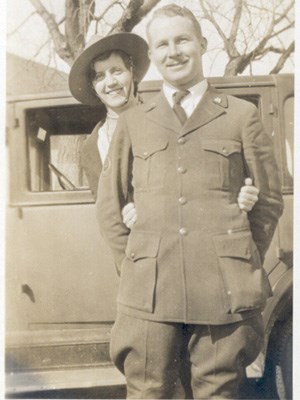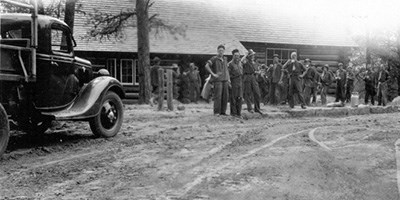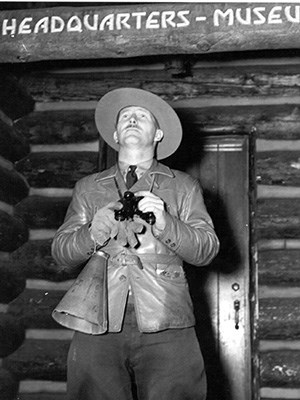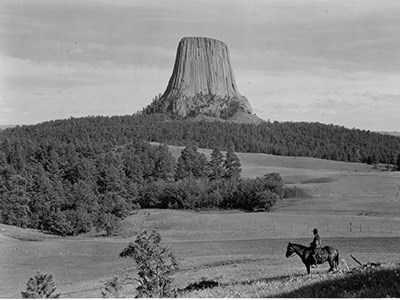
NPS photo Joyner's predecessor was the first full-time park employee, and only served in that capacity for a year. A residence had been built in the park for the custodian; Newell and Laura Joyner moved into this house during the spring of 1932. Several years later, Laura would be named "Assistant Custodian, without pay" - receiving formal recognition of her assumed duties of running the monument when her husband was not available. The Joyners would spend the next 15 years living and raising a family at the base of Devils Tower. Throughout this time, they were undaunted champions in promoting the monument and lobbying for its development as a park. Joyner had a passion for nature and eduation which led him to a career with the National Park Service. After a brief time at Yellowstone National Park and then a return to school, Joyner found himself selected for the custodian position at Devils Tower National Monument. When Newell Joyner first arrived at Devils Tower, he had three buildings, an undeveloped camping area and a government truck. A bridge over the Belle Fourche River, to allow automobile access into the monument, had been constructed in 1928. But access to the park, and visitors services at the park, were very limited. A major part of Joyner's legacy at Devils Tower would be the many improvements developed during his time as custodian. 
NPS photo Building a National MonumentJoyner arrived at Devils Tower National Monument during a fortuitous time. Within a year, Franklin Roosevelt became the United States President and implemented various public work programs. These public work programs allowed Joyner to secure funds and labor to begin the much-needed improvements at the Tower. One of the most well-known was the Civilian Conservation Corps (CCC). In 1935, at the request of Newell Joyner, a CCC camp was established on monument grounds, and major projects were swiftly completed.As a naturalist with a deep passion for museums, Joyner desired a building where visitors could learn more about the natural history of the park. He helped design and oversee construction of an administration building that would also serve as a visitor center and museum for Devils Tower National Monument. The CCC completed this building in late 1935. Improvements to the park road and trails were also made by the CCC, and Joyner saw monument visitation steadily climb throughout his tenure. Although disbanded in 1942, the work of the Civilian Conservation Corps still benefits visitors at Devils Tower and countless public lands across the country today. 
NPS photo Monumental EventsBecause of Joyner's management and development of the monument, as well as his long tenure here, he oversaw and witnessed many events which became important aspects of the park's history. Throughout the 1930s, his reports cite the huge number of people attending the "Northern Black Hills Pioneer Association picnic" (a.k.a. the Old Settlers' Picnic): over 3,600 people on June 16, 1935. In 1937, Joyner watched 3 men become the first to ascend Devils Tower using modern climbing techniques. Ever the naturalist, he asked climber and forester William House to bring down plant samples from the Tower's summit. Joyner would be present for several of the earliest climbs of Devils Tower, including a rescue operation in 1941.Possibly the most famous event occuring at Devils Tower during Joyner's custodianship was George Hopkins' ill-fated parachute jump onto the summit. On October 1, 1941, Newell Joyner watched a plane fly over the Tower and a man jump out and land on the top of his monument. Uncertain as to what was happening, or how this person was to get down, he began hollering at this unknown daredevil with the help of a megaphone. Communicating with Hopkins through shouts and notes over the next several days, Joyner handled large crowds and members of the press as the event unfolded. 
NPS photo Joyner's LegacyTheodore Roosevelt declared Devils Tower the first national monument in 1906. But it was Newell Joyner who helped turn the isolated rock formation into a true National Park Service site. His time at Devils Tower not only defined the park, but also Joyner's life, career and family. It is fitting that one of the most scenic areas of the tiny park site is named after a man so important to the park's history. Joyner Ridge offers a place of quiet reflection for visitors, even during the heat and chaos of today's modern busy season. The Joyner Ridge Trail explores the north side of Devils Tower National Monument, offering spectacular views of the Tower and peaceful strolls through beautiful forests and prairies. Whether enjoying the view from the parking area or hiking the trail, remember that these special places are often preserved for the many because of the dedication of a few. |
Last updated: August 11, 2025
